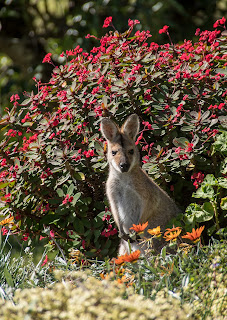Wallaby
The wallaby Bennett's is a member of Order of Diprotodonts, which means she has a pair of incisors in the lower jaw, facing forward and that the second and third fingers of her hind legs are combined with the exception of claws.
It belongs to the Macropodidae family. This word comes from Greek "macros" which means "tall" and "pode" which means "foot". All individuals have very strong back legs, equipped with long fingers and are suitable for jumping. Their front feet are small. This family includes fifty species, weighing from 1 kg to more than 80 kg.
Kangaroos and wallaby are only distinguished according to size and weight criteria: small species (less than 24 kg and less than 25 cm) are called wallabies.
Currently there are two recognized types of Bennett wallaby: (Macropus rufogriseus) and red-necked wallaby (Macropus Banksianus), located in Australia.
 lifetime : 12 to 15 years old
lifetime : 12 to 15 years oldAverage weight :Up to 27kg for a male and 16kg for a female
Sexual maturity: Around 2.5 years
Gestation: About 30 days
- Body length: 65 to 100 cm.
- Tail length: 62 to 88 cm.
- Male weight: 15 to 27 kg on average.
- Weight of the female: 11 to 16 kg on average.
wallaby has a gray-brown coat with a light ventral side. The neck and shoulders are red, the legs and muzzle dark brown. Its upper lip has a band of white hairs.
Its thick, thick fur is made of fine fibers, they act as an insulator by trapping a warm layer in contact with the skin.
His ears are wide. He can rotate them 180 ° and orient them as he wants, which is useful for picking up sound information from his environment.
Its front legs are small and thin, they end with 5 identical fingers. Their claw is short and powerful. They are used to catch items or defend themselves. The wallaby also leans on it when moving at low speed.
Its hind legs are long and robust, they are suitable for jumping. They end with 4 fingers each. Only their nail is independent. The claws of these 2 fingers make for cleaning the fur. The 4th finger is long and strong, its claw is an effective weapon against predators.
Its tail is long, muscular at its base. It is not prehensile (it cannot catch with it), but it serves as a pendulum.
- when it wants to accelerate its pace, it leaps on its hind legs, its long tail then serves as a counterweight and rudder.
It has robust and sharp incisors which cut the plants. Its powerful molars then allow it to effectively grind fibrous plants.
The wallaby is a herbivorous vegetarian, it feeds mainly on herbs. Its diet may, however, include leaves and more occasionally roots, bark, fruit and berries.
This species reproduces seasonally in Tasmania: the majority of births take place between January and July. In contrast, in Australia, young Wallabies are born throughout the year.
However, a delayed implantation can be observed in this species. If the external conditions are bad (drought, reduced food resources ...), the development of the embryo can be paused for 11 months before resuming and ending with the birth of a young.
- Time spent in pocket: around 280 days.
- Litter size: 1 to 2 small (rare).
The wallaby is not an endangered species, it is quite resistant and reproduces well. It does not benefit from protective measures. It is moreover considered as harmful in certain zones and its hunting is authorized. Its meat is then sold and consumed.



















0 comments: